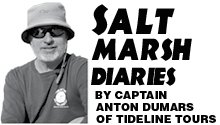 On any given day, wading birds ubiquitously dot the tidal creek banks. Like sentinels at the water’s edge, they space themselves equidistant from one another. Most common among them are the great egrets, snowy egrets, and great blue herons. Sometimes I hesitate to point them out, as if seeing one is akin to finding another sand grain on the beach. I forget that these large, majestic birds don’t stand about in everyone’s playground. Also seen along the banks are other less common waders, such as little blue herons, tricolored herons, green herons, and black crowned night herons.
On any given day, wading birds ubiquitously dot the tidal creek banks. Like sentinels at the water’s edge, they space themselves equidistant from one another. Most common among them are the great egrets, snowy egrets, and great blue herons. Sometimes I hesitate to point them out, as if seeing one is akin to finding another sand grain on the beach. I forget that these large, majestic birds don’t stand about in everyone’s playground. Also seen along the banks are other less common waders, such as little blue herons, tricolored herons, green herons, and black crowned night herons.
Carl Linnaeus developed a form of biological classification in Systema Naturae (1735). His classification method largely used shape and function observations to classify organisms. Now, grouping methods depend more on evolutionary taxonomy and, where possible, DNA comparisons. The Linnaeus two-word organism classification system (binomial nomenclature) is still used today. From most inclusive to least inclusive classification, the system goes something like this: kingdom, phylum, class, order, family, genus, and species. Now that I’ve gotten the science lesson out of the way, I’ll end this section where this discussion started. The birds mentioned above all belong to the family Ardeidae.
As ambush hunters, these tidal creek waders stalk their prey along the water’s edge. Once eyes spot the target, long necks snap sharp beaks forward to grab their prize. Being somewhat territorial, these birds tend to work a particular section of the creek bank alone. Great egrets and blue herons usually keep a respectful distance from each other, though I have seen one chase another away from a spot. Blue herons sometimes follow dolphin along a creek, hoping for a jumping mullet to land within grasp. Snowy egrets, about 1/4 the size of great egrets, have no tolerance for other nearby competitors. Seems that sometimes they spend more time chasing away foes than catching food.
Low (and lowering) tide provides the best opportunity for these birds to catch food. Oyster banks tend to trap small fish in tidal pools, which brings in the birds. As if gathering for a big family reunion, I’ve witnessed most members of Ardeidae foraging from the same fish-rich tidal pool. With plenty of food present, the birds (even the snowy egret) gain tolerance for each other.
Showing little fear for humans, green herons spend time sitting on dock lines around the marina. Their iridescent reds and greens light up in the bright low angle morning light. Stocky black crested night herons feed mostly at night, though I’ve spotted several along the creek bank during the day.
Some of these birds visit our neighborhood. Just the other day, while walking down Cooper Street, I looked over to see a great egret no more than ten feet away. Never once acknowledging me, the huge bird took two slow motion steps, and then snapped its head forward to grab a lizard. Two gulps later, the lizard became future great egret.
Anton Dumars owns and operates located at 103 East Cooper on Folly Beach. Come by for a visit or sign up for a Tideline Adventure! Visit www.tidelinetours.com or email saltmarshadventure@gmail.com or call 843-813-5009

